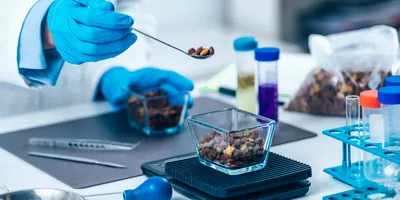Wind, sewage sludge, and wastewater carry tire wear particles from roads onto farmland. A new lab study shows: The pollutants contained in the particles could get into the vegetables grown there. Researchers at the Centre for Microbiology and Environmental Systems Science (CMESS) at the University of Vienna have investigated whether chemicals released from tires find their way into lettuce plants and could ultimately end up on our plates. Their analyses showed: The lettuce took up all the compounds studied—some of them highly toxic. Further investigations are to show how this process actually takes place in arable soils. The study has now been published in the international journal Environmental Science & Technology.
Driving a car produces tire wear particles, which are blown into the environment by the wind and washed into rivers and sewage by the rain—in total around 1 kg per citizen per year. Through the atmosphere and with the wastewater or the sewage sludge used as fertilizer in agriculture, the tire particles can reach agricultural soils. There, potentially harmful chemicals might be released from the tire into the environment: Tire wear particles and other types of microplastics contain additives, which ensure specific properties, consistencies, and the durability of these plastics. In soils, the small plastic or tire particles usually release their pollutants in the upper soil layers—this was determined in earlier studies by the research team led by environmental geoscientist Thilo Hofmann from the University of Vienna. In their current study, the researchers shed light on whether the pollutants could migrate from there into the crops.
Lettuce plants continuously take up toxic compounds from tire wear particles
"Tire wear particles contain a number of organic chemicals, some of which are highly toxic," says Anya Sherman, PhD student at the Centre for Microbiology and Environmental Systems Science (CMESS) and co-first author of the newly published study. Hofmann, head of the research group, adds: "If these chemicals are released in the root zone of edible plants, they can be a health concern for consumers—provided the chemicals are taken up by the plants." This is exactly the question the research team addressed in several experiments. The environmental geoscientists added five chemicals to the hydroponic solutions of lettuce plants. Four of these chemicals are used in tire production. Not all of them have already been confirmed to be harmful. Yet, the fifth chemical is a transformation product of one of these four, created once the tires are in use, and it is proven to be toxic: The chemical 6PPD-quinone (originating from 6PPD) has been linked to mass deaths of salmon in the US. "Our measurements showed that the lettuce plants took up all the compounds we investigated through their roots, translocated them into the lettuce leaves and accumulated them there," Sherman reports. This was also evident when the lettuce plants were not exposed to the chemicals directly, but indirectly via tire crumb. "The lettuce plants continuously take up the potentially harmful chemicals that are released from the tire abrasion particles over the long term," reports Hofmann.
Lettuce produces metabolites with as of yet unassessed toxicity
Using high resolution mass spectrometry methods, the Viennese environmental geoscientists not only measured the extent to which the previously defined chemicals ended up in the lettuce plants. They also identified the substances to which the lettuce plants metabolized the chemicals. "The plants processed the substances and in doing so they produced compounds that have not been described before. Since we don't know the toxicity of these metabolites, they pose a health risk that cannot be assessed so far," Thorsten Hüffer, senior scientist at CMESS, emphasizes. The metabolites identified by the research team are quite stable in the plant. Most likely, they would therefore be preserved until reaching our plates. "In the human body, however, such compounds are very easily broken down. Thus, if someone eats such a contaminated lettuce, the original chemicals could be released again in the body," Sherman explains.
Next step: Analysis of the described processes in soil systems and detection in environmental water
Lab Quality Management Certificate
The Lab Quality Management certificate is more than training—it’s a professional advantage.
Gain critical skills and IACET-approved CEUs that make a measurable difference.
In further studies, the Viennese research team plans to better trace the possible path of tire-wear pollutants from the road to the plate. "The processes we have investigated probably take place differently in soil systems. In a next step, we are therefore looking at the possible uptake of tire additives by plant roots in natural soils," reports co-author Ruoting Peng, who, in her dissertation project, traces the presence of an even wider range of additives in the environment, focusing on the pollution of water bodies. To better understand how such chemicals are entering the environment, in an ongoing project the research team is looking to obtain data on the concentration of these chemicals along the Danube in cooperation with the CleanDanube Project.
Microplastics in the environment: a long-term source of pollution
There, the researchers' interest revolves equally around the release mechanisms, the quantities and the long-term behavior of the pollutants. For a recent study also published in Environmental Science & Technology, the Environmental Geosciences team analyzed for how long microplastics release pollutants into the aquatic environment. In particular, they focused on phthalates—additives used primarily in the production of PVC to provide flexibility and stability. "These plasticizers have already been detected everywhere in the environment. Yet, little is known about their release process from the microplastics and how environmental conditions can influence the release," explains the first author of this study, Charlotte Henkel. "Our analyses have shown that the PVC microplastics studied can release phthalates into aquatic systems—for example rivers, lakes or groundwater—over more than 500 years." The extent to which this happens always depends on the environmental conditions. Nevertheless, according to Hofmann, the study clearly shows: "Once microplastics have reached the aquatic environment, they remain a source of potentially polluting substances, and in the case of phthalates, for a very long time."
- This press release was originally published on the University of Vienna website












